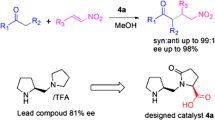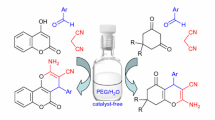Abstract
In the present report, various α-cyano hydroxylamines were synthesized via a 3-component reaction between aromatic aldehydes, phenylhydroxylamine and trimethylsilyl cyanide at room temperature. In this line, several solvents and catalysts were employed to obtain the best conditions for the reaction. Among the employed solvents and catalysts, methanol (as solvent) and NiCl2 (as catalyst) showed the highest performances. Moreover, the mechanistic details for the both steps of this reaction in the gas phase and explicit solvent (methanol) model have been studied using DFT calculations and the energy profiles for all steps were obtained. The results of these computations are in agreement with the experimental results, which showed the methanol is the best solvent and NiCl2 is the most appropriate catalyst for this reaction.











Similar content being viewed by others
References
Illgen U, Scheve J, Feldhaus R, Anders K (1982) Influence of the silica support of iron-antimony oxides on the oxidation and ammoxidation of propene. React Kinet Catal Lett 20:203–205. https://doi.org/10.1007/BF02063610
Wang Y, You J, Liu B (2019) Preparation of mesoporous silica supported sulfonic acid and evaluation of the catalyst in esterification reactions. Reac Kinet Mech Cat. https://doi.org/10.1007/s11144-019-01645-2
Krupka J, Drahonsky J, Hlavackova A (2013) Aminocarbene mechanism of the formation of a tertiary amine in nitrile hydrogenation on a palladium catalyst. Reac Kinet Mech Cat 108:91–105. https://doi.org/10.1007/s11144-012-0497-2
Zhang W, Yang C, Pan Y-L et al (2018) Synthesis of 3-cyanomethylated coumarins by a visible-light-mediated direct cyanomethylation of aryl alkynoates. Org Biomol Chem 16:5788–5792. https://doi.org/10.1039/C8OB01513A
Voznesenskaia NG, Shmatova OI, Khrustalev VN, Nenajdenko VG (2018) Enantioselective synthesis of α-perfluoroalkylated prolines, their 6,7-membered homologues and derivatives. Org Biomol Chem 16:7004–7011. https://doi.org/10.1039/C8OB01223G
Saidi MR, Azizi N (2004) A novel and efficient method for the synthesis of α-aminonitriles by the reaction of aminals with trimethylsilyl cyanide catalyzed by iodine. J Iran Chem Soc 1:136–140. https://doi.org/10.1007/BF03246106
Mojtahedi MM, Abaee MS, Abbasi H (2006) Environmentally friendly room temperature strecker reaction: one-pot synthesis of α-aminonitriles in ionic liquid. J Iran Chem Soc 3:93–97. https://doi.org/10.1007/BF03245797
Heydari A, Mehrdad M, Tavakol H (2003) One-pot synthesis of α-substituted hydroxylamine derivatives from aldehydes using lithium perchlorate/diethyl ether as a catalyst. Synthesis. https://doi.org/10.1055/s-2003-41454
Hajipour AR, Ghayeb Y, Sheikhan N (2010) Zr(HSO4)4 catalyzed one-pot strecker synthesis of α-amino nitriles from aldehydes and ketones under solvent-free conditions. J Iran Chem Soc 7:447–454. https://doi.org/10.1007/BF03246031
Safa KD, Zeinolabedini A, Abbasi H, Teimuri-Mofrad R (2013) Synthesis of new α-aminonitriles containing organosilicon groups via three component Strecker reactions. J Iran Chem Soc 10:447–452. https://doi.org/10.1007/s13738-012-0178-0
Badorrey R, Cativiela C, Díaz-De-Villegas MD et al (2005) Highly diastereoselective cyanation of methyl ketimines obtained from (R)-glyceraldehyde. J Org Chem 70:10102–10105. https://doi.org/10.1021/jo051592c
Notz W, Zhong G, Betancort JM, Iii CFB (2002) A highly enantioselective amino acid-catalyzed route to functionalized α-amino acids. J Am Chem Soc 124:8–9
Corey EJ, Grogan MJ (1999) Enantioselective synthesis of α-amino nitriles from N-benzhydryl imines and HCN with a chiral bicyclic guanidine as catalyst. Org Lett 1:157–160
Takemoto Y (2005) Recognition and activation by ureas and thioureas: stereoselective reactions using ureas and thioureas as hydrogen-bonding donors. Org Biomol Chem 3:4299–4306. https://doi.org/10.1039/b511216h
Kim TR, Kim YH, Pyun SY (1999) Kinetic studies on the addition of potassium cyanide to α, N-diphenylnitrone. Bull Korean Chem Soc 20:712–714
Bloch R (1998) Additions of organometallic reagents to C=N bonds: reactivity and selectivity. Chem Rev 98:1407–1438. https://doi.org/10.1021/cr940474e
Ros A, Díez E, Marqués-López E et al (2008) Experimental and theoretical studies on the asymmetric cyanosilylation of C2-symmetric hydrazones. Tetrahedron Asym 19:998–1004. https://doi.org/10.1016/j.tetasy.2008.03.020
Goti A, Cicchi S, Mannucci V et al (2003) iterative organometallic addition to chiral hydroxylated cyclic nitrones: highly stereoselective syntheses of α, α′- and α, α-substituted hydroxypyrrolidines. Org Lett 5:4235–4238. https://doi.org/10.1021/ol035798g
Feuer H, Torssell K (2008) Nitrile oxides, nitromes, and nitronates in organic synthesis
Coutouli-Argyropoulou E, Sarridis P, Gkizis P (2009) Water as the medium of choice for the 1,3-dipolar cycloaddition reactions of hydrophobic nitrones. Green Chem 11:1906. https://doi.org/10.1039/b916765j
Rück-Braun K, Freysoldt THE, Wierschem F (2005) 1,3-Dipolar cycloaddition on solid supports: nitrone approach towards isoxazolidines and isoxazolines and subsequent transformations. Chem Soc Rev 34:507. https://doi.org/10.1039/b311200b
Berini C, Minassian F, Pelloux-Léon N et al (2008) Efficient stereoselective nucleophilic addition of pyrroles to chiral nitrones. Org Biomol Chem 6:2574–2586. https://doi.org/10.1039/b802997k
Kissane M, Maguire AR (2010) Asymmetric 1,3-dipolar cycloadditions of acrylamides. Chem Soc Rev 39:845–883. https://doi.org/10.1039/b909358n
Tejura B, Sass DA, Fischer RA et al (2000) Transfusion-associated falciparum malaria successfully treated with red blood cell exchange transfusion. Am J Med Sci 320:337–341. https://doi.org/10.1097/00000441-200011000-00008
Lee J, Twamle B, Richter-Addo GB (2002) Nitrones are suitable ligands for heme models: X-ray crystal structure of the first metalloporphyrin nitrone complex. Chem Commun. https://doi.org/10.1039/B111057H
Hydroxylation the chemistry of bcsj.47.2583.pdf
Cooper AJL, Griffith OW (1979) N-hydroxyamino acids. Irreversible inhibitors of pyridoxal 5’-phosphate enzymes and substrates of D- and L-amino acid oxidases. J Biol Chem 254:2748–2753
Sakai T, Soeta T, Endo K et al (2013) Magnesium-tartramide complex mediated asymmetric Strecker-type reaction of nitrones using cyanohydrin. Org Lett 15:2422–2425. https://doi.org/10.1021/ol400898p
Heydari A, Larijani H, Emami J, Karami B (2000) Lithium perchlorate/diethylether-catalyzed three-component coupling reactions of aldehydes, hydroxylamines and trimethylsilyl cyanide leading to α-cyanohydroxylamines. Tetrahedron Lett 41:2471–2473. https://doi.org/10.1016/S0040-4039(00)00182-9
Chen Z, Zhou X, Xie X, Zhang X (2017) Efficient and mild Strecker-type reaction of nitrones catalyzed by MgI2 etherate. Synth Commun 47:1765–1770. https://doi.org/10.1080/00397911.2017.1350276
Heydari A, Zarei M, Alijanianzadeh R, Tavakol H (2001) One-pot synthesis of N-trimethylsilyloxy-α-amino phosphonates from aldehydes using lithium perchlorate/diethyl ether as a catalyst. Tetrahedron Lett 42:3629–3631. https://doi.org/10.1016/S0040-4039(01)00233-7
Heydari A, Tavakol H, Aslanzadeh S et al (2005) A general one-pot, three-component mono N-alkylation of amines and amine derivatives in lithium perchlorate/diethyl ether solution. Synthesis. https://doi.org/10.1055/s-2005-861798
Aidas K, Angeli C, Bak KL, Bakken V, Bast R, Boman L, Christiansen O, Cimiraglia R, Coriani S, Dahle P, Dalskov EK, Ekström U, Enevoldsen T, Eriksen JJ, Ettenhuber P, Fernández B, Ferrighi L, Fliegl H, Frediani L, Hald K, Halkier A, Hättig C, Heiberg H, Helgaker T, Hennum A, Hettema H, Hjertenæs E, Høst S, Høyvik I, Iozzi MF, Jansík B, Jensen HJ, Jonsson D, Jørgensen P, Kauczor J, Kirpekar S, Kjærgaard T, Klopper W, Knecht S, Kobayashi R, Koch H, Kongsted J, Krapp A, Kristensen K, Ligabue A, Lutnæs OB, Melo JI, Mikkelsen KV, Myhre RH, Neiss C, Nielsen CB, Normal P, Olsen J, Olsen JMH, Osted A, Packer MJ, Pawlowski F, Pedersen TB, Provasi PF, Reine S, Rinkevicius Z, Ruden TA, Ruud K, Rybkin V, Sałek P, Samson CM, de Merás AS, Saue T, Sauer SP, Schimmelpfennig B, Sneskov K, Steindal AH, Sylvester-Hvid KO, Taylor PR, Teale AM, Tellgren EI, Tew DP, Thorvaldsen AJ, Thøgersen L, Vahtras O, Watson MA, Wilson DJ, Ziolkowski M, Agren H (2014) The Dalton quantum chemistry program system. Wiley Interdiscip Rev: Comp. Mol. Sci. 43:269–284
Papajak E, Zheng J, Xu X et al (2011) Perspectives on basis sets beautiful: seasonal plantings of diffuse basis functions. J Chem Theory Comput 7:3027–3034. https://doi.org/10.1021/ct200106a
Chiodo S, Russo N, Sicilia E (2006) LANL2DZ basis sets recontracted in the framework of density functional theory. J Chem Phys 125:104107. https://doi.org/10.1063/1.2345197
Wilson AK, van Mourik T, Dunning TH (1996) Gaussian basis sets for use in correlated molecular calculations. VI. Sextuple zeta correlation consistent basis sets for boron through neon. J Mol Struct (Thoechem) 388:339–349. https://doi.org/10.1016/S0166-1280(96)80048-0
Ranjbari MA, Tavakol H (2018) Theoretical study of the possible mechanisms for the synthesis of dialkyl thiourea from dithiocarbamate. Heteroat Chem. https://doi.org/10.1002/hc.21421
Acknowledgements
We acknowledge the Institute of organic chemistry, University of Innsbruck (UIBK) for providing NMR facility. We have special thanks to Professor Ronald Micura (the head of the institute) and Professor Christoph Kreutz for their valuable assistances.
Author information
Authors and Affiliations
Corresponding author
Ethics declarations
Conflicts of interest
The authors declare no competing financial interests.
Additional information
Publisher's Note
Springer Nature remains neutral with regard to jurisdictional claims in published maps and institutional affiliations.
Electronic supplementary material
Below is the link to the electronic supplementary material.
Rights and permissions
About this article
Cite this article
Ranjbari, M.A., Tavakol, H. Synthesis of α-cyano hydroxylamines via three-component reactions and its computational mechanistic study. Reac Kinet Mech Cat 129, 349–369 (2020). https://doi.org/10.1007/s11144-019-01688-5
Received:
Accepted:
Published:
Issue Date:
DOI: https://doi.org/10.1007/s11144-019-01688-5




